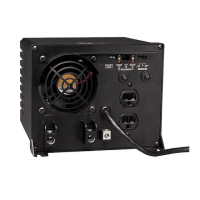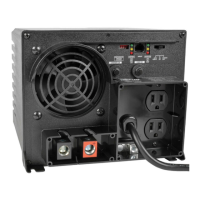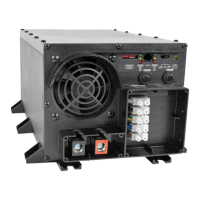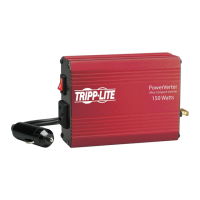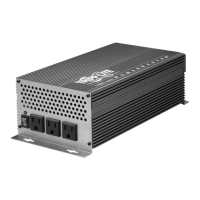9
For ease and safety, Tripp Lite recommends using Tripp Lite battery packs with your APS.
1. Make sure that your APS batteries have proper overcurrent protection.
NEC article 551 requires that you install a recognized UL component fuse block and UL listed
fuse within 18 inches of the battery. The fuse’s rating must equal or exceed the Minimum DC
Fuse Rating listed in your APS model’s specifications on pages 16 or 17. Use Littelfuse Type
#KLNR 150 (for the APS 1012) or Type # KLNR 300 (for the APS 2012) to provide overcur-
rent protection.
2. Choose a battery configuration appropriate to your batteries.
• Single Battery Connection: Refer to Diagram 5, page 36. When using a single battery, its
voltage must be equal to the voltage of your APS's Inverter Nominal Input Voltage (see
specs).
• Parallel Battery Connection: Refer to Diagram 6, page 36. When using multiple batteries
in parallel, each battery's voltage must be equal to the voltage of your APS’s Inverter
Nominal Input Voltage (see specs).
• Series Battery Connection: Refer to Diagram 7, page 37. When using multiple batteries
in series, all batteries must be equal in voltage and amp hour capacity, and the sum of their
voltages must be equal to the voltage of your APS's Inverter Nominal Input Voltage (see specs).
3. Securely fasten the APS’s DC power terminals to the battery terminals.
Use 2/0 gauge cable for battery connection. Battery connection cable lengths should be short
as possible, and never greater than 20 feet. Using longer cables, or cables of a smaller gauge,
could result in dangerous overheating or fire.*
* APS models are capable of delivering a much higher wattage output for brief periods of time. Wiring should be
configured to handle this brief high-current draw. Though your APS is a high-efficiency converter of electricity, its
rated output capacity is limited by the length and gauge of the wires running from the battery to the APS.
Instead of connecting the APS to its own battery array, you may connect it to a vehicle’s battery.
Note: An APS can ONLY be connected to vehicle batteries if their voltage matches the APS’s
Nominal DC Input—12V vehicle batteries to 12V Nominal DC Input APS systems, etc. (See
Specifications). There are two main ways to make this sort of vehicular battery connection.
Choose the Basic Connection if you are running light hand tools or other small appliances for a
brief period of time (see Diagram 8, p. 37). Choose the Advanced Connection if you are using
your APS to power heavy loads for extended periods of time (see Diagram 9, p. 37). The
Advanced Connection incorporates a battery isolator and separate battery system to provide
battery power to your APS while preventing it from draining your vehicle’s battery. Note: Depending
on your application, you may require more than one Deep Cycle Battery.
Note: When installing your APS, the main ground lug must be connected to the vehicle chassis. A non-grounded unit
could cause an electrical shock hazard.
Caution: Never operate your APS from an alternator without a battery connected as shown in Diagrams 7 or 8, p. 37.
Battery Connection
Connection to External Batteries
Connection to Vehicle Battery
